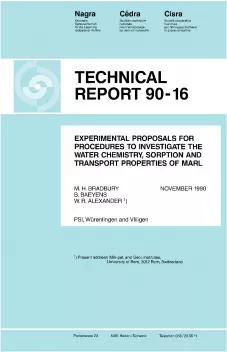
Technical Report NTB 90-16
Experimental proposals for procedures to investigate the water chemistry, sorption and transport properties of marl
The aim of this report is to describe a framework within which laboratory studies on groundwater chemistry, sorption and transport properties might be conducted on samples from rock formations being considered as potential "host rocks" for the disposal of radioactive waste. Here, Valanginian marl has been taken as a specific example, but the general principles should be applicable to other systems.
Some brief notes are given on sampling and handling procedures and mineralogical characterisation. This is followed by a detailed discussion of the procedures considered necessary to determine a groundwater chemistry of a specific rock matrix. The methods described are particularly appropriate to rocks such as marl, i.e. low water content rocks (essentially "dry") with appreciable clay and carbonate contents. An important conclusion drawn is that simple aqueous phase extractions at different liquid to solid ratios, followed by extrapolation procedures, are not always appropriate and can lead to incorrect water compositions.
Some of the uncertainties and difficulties inherently involved in determining sorption parameters from batch, infiltration and diffusion based methods are presented. These methods are then individually discussed in greater detail with some illustrative examples.
In the relatively few studies where sorption has been measured in crushed rock tests and compared with the results from intact rock experiments, it is often found that there are discrepancies. An outline for an experiment is described in which results from the two types of test could be quantitatively related to one another via cation exchange capacity measurements. Using this method it might be possible to explain the reasons for such discrepancies.
Finally, a brief discussion is given on the possible consequences for experimental studies of gas in Valanginian marl and the swelling of the clay rich components.
The authors would like to point out that the opinions, ideas and concepts put forward in this report represent their views at a certain point in time (October 1989) before the experimental programme on marl was fully underway. Practical experience will ultimately be the judge of the contents of this work. Even if some of the ideas are later shown to be in error, this exercise is nevertheless considered to have been useful since it has provided a background to the experimental work and a framework upon which future developments can be built.
